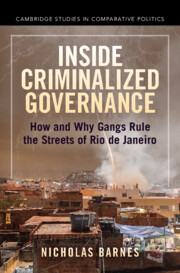Book contents
- Inside Criminalized Governance
- Cambridge Studies in Comparative Politics
- Inside Criminalized Governance
- Copyright page
- Dedication
- Contents
- Figures
- Tables
- Acknowledgments
- A Note on Translation
- Abbreviations, Acronyms, and Translated Words
- 1 Introduction
- 2 Criminalized Governance
- 3 A Theory of Criminalized Governance
- 4 The Origins of Criminalized Governance
- 5 Comando Vermelho of Nova Holanda
- 6 Comando Vermelho of Parque União
- 7 Terceiro Comando (Puro) of Complexo da Maré
- 8 Criminalized Governance during Military Occupation
- 9 Conclusion
- 10 Epilogue
- Appendices
- References
- Index
- Other Books in the Series (continued from page ii)
5 - Comando Vermelho of Nova Holanda
Published online by Cambridge University Press: 06 February 2025
- Inside Criminalized Governance
- Cambridge Studies in Comparative Politics
- Inside Criminalized Governance
- Copyright page
- Dedication
- Contents
- Figures
- Tables
- Acknowledgments
- A Note on Translation
- Abbreviations, Acronyms, and Translated Words
- 1 Introduction
- 2 Criminalized Governance
- 3 A Theory of Criminalized Governance
- 4 The Origins of Criminalized Governance
- 5 Comando Vermelho of Nova Holanda
- 6 Comando Vermelho of Parque União
- 7 Terceiro Comando (Puro) of Complexo da Maré
- 8 Criminalized Governance during Military Occupation
- 9 Conclusion
- 10 Epilogue
- Appendices
- References
- Index
- Other Books in the Series (continued from page ii)
Summary
This chapters traces the evolution of the Nova Holanda gang’s governance practices from the mid-1990s until the occupation of Maré by the Brazilian Military in April 2014 through the analysis of newspaper archives, oral histories with residents and gang members, and a dataset of anonymous gang denunciations. Following its integration into the Comando Vermelho faction, CVNH maintained a benevolent dictator regime, combining high levels of coercion with responsive benefits, until several years of warfare with their primary rival led to the use of extreme forms of coercion against residents as disorder prevailed. By 2004, the war between CVNH and Terceiro Comando Puro (TCP) had ended though enforcement continued to be active and frequent, leading to a social bandit regime, in which the gang offered significant benefits and engaged in low levels of coercion. Then, following the resurgence of TCP in 2009 until the arrival of the Brazilian military, CVNH can be considered a benevolent dictator gang once again. They ramped up their coercive behavior in response to TCP’s more aggressive posture while providing significant benefits to avoid frequent police enforcement efforts.
Keywords
- Type
- Chapter
- Information
- Inside Criminalized Governance , pp. 136 - 172Publisher: Cambridge University PressPrint publication year: 2025

